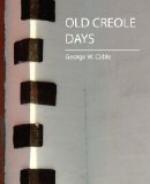During the first quarter of the present century, the free quadroon caste of New Orleans was in its golden age. Earlier generations—sprung, upon the one hand, from the merry gallants of a French colonial military service which had grown gross by affiliation with Spanish-American frontier life, and, upon the other hand from comely Ethiopians culled out of the less negroidal types of African live goods, and bought at the ship’s side with vestiges of quills and cowries and copper wire still in their head-dresses,—these earlier generations, with scars of battle or private rencontre still on the fathers, and of servitude on the manumitted mothers, afforded a mere hint of the splendor that was to result from a survival of the fairest through seventy-five years devoted to the elimination of the black pigment and the cultivation of hyperian excellence and nymphean grace and beauty. Nor, if we turn to the present, is the evidence much stronger which is offered by the gens de couleur whom you may see in the quadroon quarter this afternoon, with “Ichabod” legible on their murky foreheads through a vain smearing of toilet powder, dragging their chairs down to the narrow gateway of their close-fenced gardens, and staring shrinkingly at you as you pass, like a nest of yellow kittens.
But as the present century was in its second and third decades, the quadroones (for we must contrive a feminine spelling to define the strict limits of the caste as then established) came forth in splendor. Old travellers spare no terms to tell their praises, their faultlessness of feature, their perfection of form, their varied styles of beauty,—for there were even pure Caucasian blondes among them,—their fascinating manners, their sparkling vivacity, their chaste and pretty wit, their grace in the dance, their modest propriety, their taste and elegance in dress. In the gentlest and most poetic sense they were indeed the sirens of this land where it seemed “always afternoon”—a momentary triumph of an Arcadian over a Christian civilization, so beautiful and so seductive that it became the subject of special chapters by writers of the day more original than correct as social philosophers.
The balls that were got up for them by the male sang-pur were to that day what the carnival is to the present. Society balls given the same nights proved failures through the coincidence. The magnates of government,—municipal, state, federal,—those of the army, of the learned professions and of the clubs,—in short, the white male aristocracy in every thing save the ecclesiastical desk,—were there. Tickets were high-priced to insure the exclusion of the vulgar. No distinguished stranger was allowed to miss them. They were beautiful! They were clad in silken extenuations from the throat to the feet, and wore, withal, a pathos in their charm that gave them a family likeness to innocence.
Madame Delphine, were you not a stranger, could have told you all about it; though hardly, I suppose, without tears.




